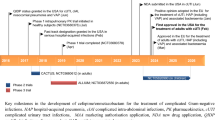Abstract
Selection of empirical treatment of hospitalized patients with urinary tract infection (UTI) is usually based on the results of urine culture as obtained from the local microbiology laboratory. In order to improve the precision and reliability of traditional methods, we analyzed temporal changes in the results of urine culture and antibiograms and stratified the results by inpatient department and the presence/absence of an indwelling catheter. The database consisted of urine cultures obtained during the first 3 months of each year over a 10-year period between 1991 and 2000. Only urine samples that grew a single organism at a concentration of >105 cfu were included in the analysis. Trend statistical tools, readily available but thus far not used for microbiological analyses, were applied to assess the decay in activity of individual antibiotic agents over time and to calculate susceptibility rates of organisms in subsets of urine samples. Organisms, antimicrobial susceptibility rates and the degree of decay in antimicrobial susceptibility rates varied significantly according to the location of the patient in the hospital and the presence of an indwelling catheter. Stratified trend analysis is a useful tool that can be helpful in designing and adapting clinical guidelines for the selection of appropriate empirical antibiotic treatment for the individual patient with urinary tract infection.

Similar content being viewed by others
References
Sobel JD, Kaye D (2000) Urinary tract infections. In: Mandell GL, Bennett JE, Dolin R (eds) Principles and practice of infectious diseases. Churchill Livingstone, Philadelphia, pp 773–805
Stamm WE, Hooton TM (1993) Management of urinary tract infections in adults. N Engl J Med 329:1328–1333
Elhanan G, Sarhat M, Raz R (1997) Empiric antibiotic treatment and the misuse of culture results and antibiotic sensitivities in patients with community-acquired bacteremia due to urinary tract infection. J Infect 35:283–288
Yinnon AM, Schlesinger Y, Gabbay D, Rudensky B (1997) Importance of stratification of microbial susceptibilities by source of patients. J Infect 35:17–23
Warren JW (2000) Nosocomial urinary tract infections. In: Mandell GL, Bennett JE, Dolin R (eds) Principles and practice of infectious diseases. Churchill Livingstone, Philadelphia, pp 3028–3039
Saint S, Scholes D, Fihn SD, Farrell RG, Stamm WE (1999) The effectiveness of a clinical practice guideline for the management of presumed uncomplicated urinary tract infection in women. Am J Med 106:636–641
Clarridge JE, Pezzlo MT, Vosti KL (1987) Laboratory diagnosis of urinary tract infections. In: Weissfeld AC (ed) Cumitech 2A. American Society for Microbiology, Washington DC
Clarridge JE, Johnson JR, Pezzlo MT (1998) Laboratory diagnosis of urinary tract infections. In: Weissfeld AC (ed) Cumitech 2B. American Society for Microbiology, Washington DC
Aspevall O, Hallander H, Gant V, Kouri T (2001) European guidelines for urinalysis: a collaborative document produced by European clinical microbiologists and clinical chemists under ECLM in collaboration with ESCMID. Clin Microbiol Infect 7:173–178
Morgan MG, McKenzie H (1993) Controversies in the laboratory diagnosis of community-acquired urinary tract infection. Eur J Clin Microbiol Infect Dis 12:491–504
Rosenberg M, Berger SA, Barki M, Goldberg S, Fink A, Miskin A (1992) Initial testing of a novel urine culture device. J Clin Microbiol 30:2686–2691
Jorgensen JH, Turnidge JD, Washington JA (1999) Antimicrobial susceptibility tests: dilution and disk diffusion methods. In: Murray PR, Baron EJ, Pfaller MA, Tenover FC, Yolken RH (eds) Manual of clinical microbiology. American Society for Microbiology, Washington DC, pp 1526–1543
Snedecor GW, Cochran WG (1980) Statistical methods. Iowa State University Press, Ames, IA, pp 206–208
Abramson JH, Gahlinger M (1999) Computer programs for epidemiologists: PEPI version 3.01. Brixton Books, Llanidloes, Powys, Wales
Toledano H, Schlesinger Y, Raveh D, Rudensky M, Attias D, Eidelman AI, Yinnon AM (2000) Vancomycin-resistant Enterococcus colonization in the neonatal intensive care unit: a longitudinal study. Eur J Clin Microbiol Infect Dis 19:282–287
Yinnon AM, Butnaru A, Raveh D, Jerassy Z, Rudensky B (1996) A six-year survey of Klebsiella bacteremia: community versus nosocomial infection. Quart J Med 89:933–941
Tallis E, Rudensky B, Attias D, Yinnon AM (1999) In vitro susceptibility of diverse groups of Enterobacteriaceae and Staphylococcus aureus to cefepime and comparable antimicrobials. Diagn Microbiol Infect Dis 35:121–126
Rice LB, Eckstein EC, DeVente J, Shlaes DM (1996) Ceftazidime-resistant Klebsiella pneumoniae isolates recovered at the Cleveland department of Veteran Affairs Medical Center. Clin Infect Dis 23:118–124
Patterson JE, Hardin TC, Kelly CA, Garcia RC, Jorgensen JH (2000) Association of antibiotic utilization measures and control of multiple drug resistance in Klebsiella pneumoniae. Infect Control Hosp Epidemiol 21:455–458
Gupta K, Hooton TM, Stamm WE (2001) Increasing antimicrobial resistance and the management of uncomplicated urinary tract infections. Ann Intern Med 135:41–50
Hooton TM, Stamm WE (1997) Diagnosis and treatment of uncomplicated urinary tract infection. Infect Dis Clin North Am 11:551–581
McCarty JM, Huck RG, Tucker RM, Tosiello RI, Shan M, et al (1999) A randomized trial of short-course ciprofloxacin, ofloxacin, or trimethoprim/sulfamethoxazole for the treatment of acute urinary tract infection in women. Am J Med 106:292–299
Talan DA, Stamm WE, Hooton TM, Moran GJ, Burke T, Iravani A, et al (2000) Comparison of ciprofloxacin (7 days) and trimethoprim-sulfamethoxazole (14 days) for acute uncomplicated pyelonephritis in women: a randomized trial. JAMA 283:1583–1590
Paraskaki I, Lebessi E, Legakis NJ (1996) Epidemiology of community-acquired Pseudomonas aeruginosa infections in children. Eur J Clin Microbiol Infect Dis 15:782–786
Maranan M, Hatch D, Lindgren B, Rowley AH (1997) Community-acquired Pseudomonas aeruginosa infection in preschool children. Pediatr Nephrol 11:126–127
Author information
Authors and Affiliations
Corresponding author
Rights and permissions
About this article
Cite this article
Raveh, D., Rudensky, B., Huerta, M. et al. Use of Time-Trend Analysis in the Design of Empirical Antimicrobial Treatment of Urinary Tract Infection. Eur J Clin Microbiol Infect Dis 22, 158–164 (2003). https://doi.org/10.1007/s10096-003-0905-7
Published:
Issue Date:
DOI: https://doi.org/10.1007/s10096-003-0905-7




